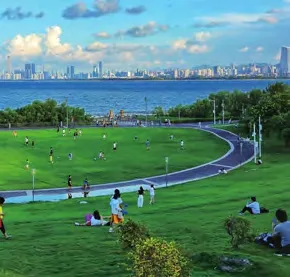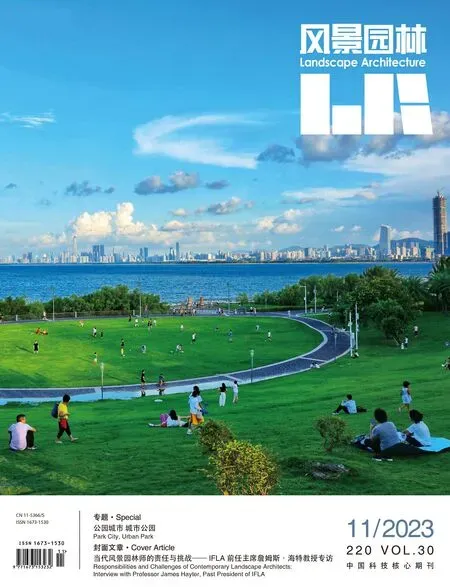城市的公园,公园的城市

我们面临着日益严重的气候变化挑战,随着人类社会迈入生态文明时代,构建一个地球生命共同体已经成为当务之急。与此同时,数字技术所驱动的技术融合革命正在深刻影响城市空间特征。在此背景下,风景园林如何响应全球的环境挑战,并充分把握新技术带来的机遇?我们回首过去,可以发现公园曾经是城市中的一个独特存在,为工业化时代的都市提供了一个呼吸的绿洲,为所有人提供可以公平享用的社会空间场地。伴随着时代的变迁和技术的进步,公园不再仅仅是作为城市的补充或缓冲的绿色空间,而是与人们的日常生活更为紧密地结合在一起,与城市的形态更为紧密地结合在一起。这种融合的趋势导致公园的角色和形态也在逐渐发生转变。
英国是最早进行工业革命的国家,其工业革命到19世纪30年代前后已基本完成。城市工业的迅猛发展,吸引人们纷纷涌向城市,导致英国农业人口锐减,城市人口剧增,城市规模随之急剧扩大,造成住房短缺、交通拥挤、环境恶化的城市状况。为应对这些挑战,风景园林行业积极响应,兴建城市公园,私家园林开始向公众开放或被改造成公园。设计者在城市公园的建设过程中,也在逐步考虑整体性和连接性的问题,并开始连接公园、构建绿道、建设城市绿地系统,旨在为城市居民提供一个覆盖范围更大的绿色宜人环境。“二战”后,全球进入了经济复苏和高速增长的时期。随着世界经济的繁荣和人口的大幅增长,自然环境受到了空前的破坏。城市逐渐呈现出高密度化的特点,特大城市和都市圈逐渐形成,郊区化也开始呈现。在这一背景下,风景园林开始介入城市更新和郊区化进程,国际风景园林师联合会(International Federation of Landscape Architects, IFLA)成立,环境保护运动逐渐兴起,这表明了人们对环境保护的关注和需求。
伴随着信息时代的到来,计算机带来了信息技术革命。城市开始展现第三产业空间的增加,部分工业城市出现收缩,城市的历史文脉逐渐丧失。风景园林行业在这一阶段开始受到波普艺术、解构主义等多种思潮的影响,与不同的艺术流派结合,尝试寻找新的表达方式和创新手法。随着全球化进程加速,通信和交通技术日新月异,各国之间的联系变得前所未有的紧密。城市呈现出去工业化、去中心化的特点,气候风险开始影响城市的韧性和可持续性。风景园林行业开始注重可持续景观、景观都市主义、景观绩效和文化景观的保护,强调环境、文化和历史的完整性。
进入生态文明时代,数字技术驱动了技术融合革命,如移动互联网、物联网、智能制造和人工智能,都在改变我们的生活方式。城市开始展现出虚实融合的空间特征,以人为核心的共享城市空间逐渐形成,建设城市韧性环境以应对气候变化成为趋势。风景园林行业聚焦全球气候变化,开始尝试碳中和、利用传统生态智慧和数字技术构建园林。
公园,从最初作为工业城市的“良药”,一直以来都是人们对抗城市污染治理、喧嚣的一片净土。但随着技术的进步和城市的进一步演变,我们看到了公园从传统的概念向“无界公园”的方向发展,与城市和日常生活更加紧密地融合。甚至可以预见,未来的城市将不再有传统意义上的“公园”,而是整个城市将成为一个巨大的公园。从公园作为工业城市的“良药”到整个城市成为一个公园,这将是一个漫长而富有意义的历程。
在城市进入从增量扩张到存量提质的阶段,“公园”开放共享、公平共治、无界融合,场景营造成为城市高质量发展的重要手段,我们可以预见城市与自然、技术与生活之间的界限将越来越模糊,而风景园林设计将更加注重人与自然的共生,以及人们在其中的精神与情感体验。此刻,风景园林挑战与机遇并存,需要思考的不仅是如何设计一个功能性强的公园,而是要考虑如何在全球环境变化的大背景下,设计出能够适应未来变化,塑造城市形态,具有生态、社会、经济可持续性的新“公园”。这需要超越传统设计的界限,融合生态学、社会学、技术科学等多学科的知识,以创新的视角来塑造适应我们这个时代之需的职业实践。
Park in City, City in Park
Humans are facing the increasingly aggravated challenge of climate change.As human society moves into the era of ecological civilization, constructing a global community of life has become an uppermost priority.In the meantime, the revolution of technological convergence driven by digital technology is profoundly affecting the spatial characteristics of cities.In this context, how would landscape architecture respond to the global environmental challenges, while taking full leverage of the opportunities brought about by new technologies? In retrospection, we can conclude that parks were once a unique presence in cities, providing a breathing oasis for the industrialized metropolis and offering a social spatial venue for all persons to enjoy equitably.Along with changing times and technological advances, parks are no longer just green spaces acting as a complement or buffer for cities.Instead, they get more closely integrated both with people’s daily lives and cities’ morphologies.This trend of integration is gradually shifting the roles and forms of parks themselves.
As the first country to implement the Industrial Revolution,UK had basically completed this revolution approximately in 1830s.The rapid development of urban industry attracted people to flock to cities, leading to a plummet in Britain’s agricultural population and a surge in its urban population.Consequently, the urban scale was expanded dramatically, bad urban conditions came as follow: shortage of houses, congestion of traffics, and degradation of environment.In response to these challenges, the landscape architecture industry took active actions by building urban parks, while some private gardens began to be opened to the public or were transformed into parks.In the process of constructing urban parks, designers were gradually considering the issues of integrality and connectivity, while starting to connect parks, build greenways, and build up urban green space systems, purposed to provide urban residents with a green and pleasant environment of a larger coverage.After World War II, the world entered a period of economic recovery and rapid growth.With the prosperity of the world’s economy as well as the huge growth of global population, the natural environment has been damaged in an unprecedented manner.With cities gradually showcasing the characteristics of high density, megacities and metropolitan areas have been formed little by little, and suburbanization has also begun to appear.Under this background, landscape architecture started to go into the process of urban renewal and suburbanization, and the International Federation of Landscape Architects (IFLA) was founded.The rise of environmental protection movements reveals people’s concern over, and demand for, environmental protection.
With the advent of the information age, computers have brought about a revolution of information technology.Cities begin to demonstrate an increase in the tertiary industry’s space, with some industrial cities being contracted, so cities start to lose their cultural and historical context.In this stage, influenced by a variety of trends of thought, such as pop art and deconstructionism, the landscape architecture industry began to attempt to find new ways of expression and innovative techniques by integrating with different art genres.With accelerated globalization and ever-updated communication and transportation technologies, the links between countries became close in a pattern never seen before.Cities presented the features of de-industrialization and de-centralization, and climate risks were beginning to compromise the resilience and sustainability of cities.The landscape architecture industry began to pay much attention to sustainable landscapes, landscape urbanism, landscape performance,and the preservation of cultural landscapes, with an emphasis on environmental, cultural and historical integrity.
Since entering the era of ecological civilization, digital technologies have driven a revolution of technological convergence.For example,the mobile Internet, the Internet-of-Things, smart manufacturing,and artificial intelligence are all re-shaping our lifestyles.Cities have begun to present a spatial characteristic of virtuality-and-reality fusion; human-centered shared urban space is gradually taking shape;and it has become a trend to forge resilient urban environments, so as to cope with climate change.Focusing on global climate change,the landscape architecture industry has attempted to build landscape spaces with carbon neutrality, while utilizing traditional ecological wisdom and digital technology.
Parks, as a “cure” for industrial cities in the early years, have always been a clean space for people to combat the pollution and hustle and bustle across cities.However, with the advancement of technology and the further evolution of cities, it can be observed that parks are evolving from a traditional concept to the direction of“parks without boundaries” by getting more closely with cities and daily life.It is even foreseeable that in the future, cities will no longer have “parks” in the traditional sense; rather, a whole city will become a giant park.It would be a long and meaningful journey to go from parks as the “cure” for industrial cities to a-whole-city-as-a-park.
In this phase that cities are shifting from incremental expansion to stock improvement, “parks” become an important means for highquality development of cities by open sharing, fair co-governance,boundless convergence and scenario construction.It is foreseeable that the boundaries between cities and nature as well as between technology and life will get increasingly blurred, while the design of landscape architecture will attach more attention to the symbiosis between human and nature, as well as the spiritual and emotional experience of people in them.Nowadays, landscape architecture is facing both challenges and opportunities, so we shall think about not only how to design a functionality-strong park, but also how to create an ecologically, socially and economically sustainable new“park” that can adapt to future changes and shape urban forms in the grand context of global environmental change.This entails a kind of professional practice that can go beyond the boundaries of traditional design by integrating knowledge from ecology, sociology, technical sciences and many other subjects, so as to shape and meet the needs of our epoch in an innovative perspective.
Editor-in-Chief: ZHENG Xi
November 2, 2023

